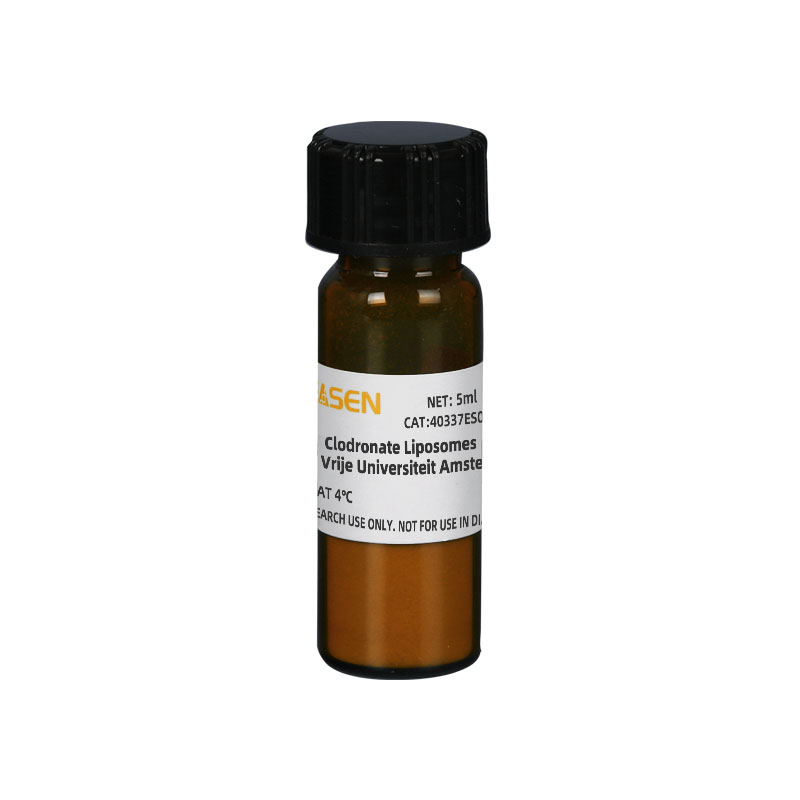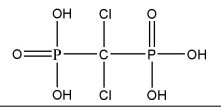Clodronate Liposomes(From Vrije Universiteit Amsterdam)
Product Description
Clodronate liposomes are applicable to a variety of injection methods, such as intravenous injection, intraperitoneal injection, subcutaneous injection, intranasal injection and testicular injection. The amount of injection was related to the weight of mice, injection cycle, injection method, and experimental purpose.
Product characteristics
|
Solution |
10 mM Na2HPO4,10 mM NaH2PO4,140 mM NaCl |
|
Concentration |
5 mg/mL |
|
Lipid composition |
Phosphatidylcholine and cholesterol |
|
Structure |
|
Shipping and Storage
The components are shipped with ice pack and can be stored at 4 ℃ for 3 months. Cannot be frozen!
Cautions
1. Before use, it must be fully mixed and restored to room temperature.
2. For research use only!
Instructions
Please refer to relevant literature for specific injection volume, and explore and optimize according to your own experimental conditions (such as experimental purpose, injection method, injection cycle).
Intraperitoneal injection
1. Before injection, remove clodronate liposomes and sterile PBS (for injection) from the refrigerator. Naturally return to room temperature (18 ℃).
[Notes]: Clodronate liposomes suspension shall not be frozen and shall not exceed 30 ℃.
2. Upside down for 8-10 times. Connect a 26 gauge needle to a 1ml syringe and suck 200 μL Clodronate liposomes .
3. Grab enough skin behind the ears of the mouse and tail with the left hand to fix the head and limbs.
4. Tilt the mouse slightly and let the head face the ground, so that the organ originally concentrated at the lower right of the abdomen moves towards the head and away from the injection site.
5. Before injection, reverse the syringe for 6 times and mix clodronate liposomes.
[Notes]: Long time placement will cause liposomes to precipitate in the syringe, resulting in uneven concentration during the injection.
6. The needle is inserted into the lower right side of the abdomen at an angle of 30 degrees. 200 μL injections respectively clodronate liposomes (experimental group) and PBS (control group).
Reference
[1] Song C, Li H, Li Y, et al. NETs promote ALI/ARDS inflammation by regulating alveolar macrophage polarization[J]. Experimental Cell Research, 2019, 382(2): 111486.
[2] Jiang P, Gao W, Ma T, et al. CD137 promotes bone metastasis of breast cancer by enhancing the migration and osteoclast differentiation of monocytes/macrophages[J]. Theranostics, 2019, 9(10): 2950.
[3] Yang L, Dong C, Tian L, et al. Gadolinium Chloride Restores the Function of the Gap Junctional Intercellular Communication between Hepatocytes in a Liver Injury[J]. International Journal of Molecular Sciences, 2019, 20(15): 3748.
[4] Wu H, Xu X, Li J, et al. TIM 4 blockade of KCs combined with exogenous TGF β injection helps to reverse acute rejection and prolong the survival rate of mice receiving liver allografts[J]. International Journal of Molecular Medicine, 2018, 42(1): 346-358.
[5] Tian L, Li W, Yang L, et al. Cannabinoid receptor 1 participates in liver inflammation by promoting M1 macrophage polarization via RhoA/NF-κB p65 and ERK1/2 pathways, respectively, in mouse liver fibrogenesis[J]. Frontiers in Immunology, 2017, 8: 1214.
[6] Li W, Chang N, Tian L, et al. miR-27b-3p, miR-181a-1-3p, and miR-326-5p are involved in the inhibition of macrophage activation in chronic liver injury[J]. Journal of Molecular Medicine, 2017, 95(10): 1091-1105.
[1] Xiong X, Chen S, Shen J, et al. Cannabis suppresses antitumor immunity by inhibiting JAK/STAT signaling in T cells through CNR2. Signal Transduct Target Ther. 2022;7(1):99. Published 2022 Apr 6. doi:10.1038/s41392-022-00918-y(IF:18.187)
[2] Zhang Z, Chen C, Yang F, et al. Itaconate is a lysosomal inducer that promotes antibacterial innate immunity [published online ahead of print, 2022 May 25]. Mol Cell. 2022;S1097-2765(22)00443-9. doi:10.1016/j.molcel.2022.05.009(IF:17.970)
[3] Cai J, Peng J, Zang X, et al. Mammary Leukocyte-Assisted Nanoparticle Transport Enhances Targeted Milk Trace Mineral Delivery [published online ahead of print, 2022 Jun 30]. Adv Sci (Weinh). 2022;e2200841. doi:10.1002/advs.202200841(IF:17.521)
[4] Jin H, Liu K, Tang J, et al. Genetic fate-mapping reveals surface accumulation but not deep organ invasion of pleural and peritoneal cavity macrophages following injury. Nat Commun. 2021;12(1):2863. Published 2021 May 17. doi:10.1038/s41467-021-23197-7(IF:14.919)
[5] Sheng D, Ma W, Zhang R, et al. Ccl3 enhances docetaxel chemosensitivity in breast cancer by triggering proinflammatory macrophage polarization [published correction appears in J Immunother Cancer. 2022 Jun;10(6):]. J Immunother Cancer. 2022;10(5):e003793. doi:10.1136/jitc-2021-003793(IF:13.751)
[6] Zhao L, Zhang H, Liu X, et al. TGR5 deficiency activates antitumor immunity in non-small cell lung cancer via restraining M2 macrophage polarization. Acta Pharm Sin B. 2022;12(2):787-800. doi:10.1016/j.apsb.2021.07.011(IF:11.614)
[7] Xia L, Zhang C, Lv N, et al. AdMSC-derived exosomes alleviate acute lung injury via transferring mitochondrial component to improve homeostasis of alveolar macrophages. Theranostics. 2022;12(6):2928-2947. Published 2022 Mar 21. doi:10.7150/thno.69533(IF:11.556)
[8] Zhang X, Hou L, Li F, et al. Piezo1-mediated mechanosensation in bone marrow macrophages promotes vascular niche regeneration after irradiation injury. Theranostics. 2022;12(4):1621-1638. Published 2022 Jan 16. doi:10.7150/thno.64963(IF:11.556)
[9] Wang H, Li L, Li Y, et al. Intravital imaging of interactions between iNKT and kupffer cells to clear free lipids during steatohepatitis. Theranostics. 2021;11(5):2149-2169. Published 2021 Jan 1. doi:10.7150/thno.51369(IF:11.556)
[10] Xun J, Du L, Gao R, et al. Cancer-derived exosomal miR-138-5p modulates polarization of tumor-associated macrophages through inhibition of KDM6B. Theranostics. 2021;11(14):6847-6859. Published 2021 May 3. doi:10.7150/thno.51864(IF:11.556)
[11] Zuo L, Li J, Zhang X, et al. Aberrant mesenteric adipose extracellular matrix remodeling is involved in adipocyte dysfunction in Crohn's disease: The role of TLR-4-mediated macrophages [published online ahead of print, 2022 Jun 16]. J Crohns Colitis. 2022;jjac087. doi:10.1093/ecco-jcc/jjac087(IF:9.071)
[12] Huang C, Wang J, Liu H, et al. Ketone body β-hydroxybutyrate ameliorates colitis by promoting M2 macrophage polarization through the STAT6-dependent signaling pathway. BMC Med. 2022;20(1):148. Published 2022 Apr 15. doi:10.1186/s12916-022-02352-x(IF:8.775)
[13] Jiang P, Gao W, Ma T, et al. CD137 promotes bone metastasis of breast cancer by enhancing the migration and osteoclast differentiation of monocytes/macrophages. Theranostics. 2019;9(10):2950-2966. Published 2019 May 9. doi:10.7150/thno.29617(IF:8.063)
[14] Yang XL, Wang G, Xie JY, et al. The Intestinal Microbiome Primes Host Innate Immunity against Enteric Virus Systemic Infection through Type I Interferon. mBio. 2021;12(3):e00366-21. Published 2021 May 11. doi:10.1128/mBio.00366-21(IF:7.867)
[15] Sun Z, Huang W, Zheng Y, et al. Fpr2/CXCL1/2 Controls Rapid Neutrophil Infiltration to Inhibit Streptococcus agalactiae Infection. Front Immunol. 2021;12:786602. Published 2021 Nov 24. doi:10.3389/fimmu.2021.786602(IF:7.561)
[16] Cai J, Cui X, Wang X, You L, Ji C, Cao Y. A Novel Anti-Infective Peptide BCCY-1 With Immunomodulatory Activities. Front Immunol. 2021;12:713960. Published 2021 Jul 22. doi:10.3389/fimmu.2021.713960(IF:7.561)
[17] Li C, Song J, Guo Z, et al. EZH2 Inhibitors Suppress Colorectal Cancer by Regulating Macrophage Polarization in the Tumor Microenvironment. Front Immunol. 2022;13:857808. Published 2022 Apr 1. doi:10.3389/fimmu.2022.857808(IF:7.561)
[18] Tian L, Li W, Yang L, et al. Cannabinoid Receptor 1 Participates in Liver Inflammation by Promoting M1 Macrophage Polarization via RhoA/NF-κB p65 and ERK1/2 Pathways, Respectively, in Mouse Liver Fibrogenesis. Front Immunol. 2017;8:1214. Published 2017 Sep 28. doi:10.3389/fimmu.2017.01214(IF:6.429)
[19] Wang X, Li W, Jiang H, et al. Zebrafish Xenograft Model for Studying Pancreatic Cancer-Instructed Innate Immune Microenvironment. Int J Mol Sci. 2022;23(12):6442. Published 2022 Jun 9. doi:10.3390/ijms23126442(IF:5.924)
[20] Xiong C, Zhu Y, Xue M, et al. Tumor-associated macrophages promote pancreatic ductal adenocarcinoma progression by inducing epithelial-to-mesenchymal transition. Aging (Albany NY). 2021;13(3):3386-3404. doi:10.18632/aging.202264(IF:5.682)
[21] Wang J, Li X, Wang Y, Li Y, Shi F, Diao H. Osteopontin aggravates acute lung injury in influenza virus infection by promoting macrophages necroptosis. Cell Death Discov. 2022;8(1):97. Published 2022 Mar 4. doi:10.1038/s41420-022-00904-x(IF:5.241)
[22] Ma Y, Liang Y, Wang N, et al. Avian Flavivirus Infection of Monocytes/Macrophages by Extensive Subversion of Host Antiviral Innate Immune Responses. J Virol. 2019;93(22):e00978-19. Published 2019 Oct 29. doi:10.1128/JVI.00978-19(IF:5.103)
[23] Jiang Q, Li W, Zhu X, et al. Estrogen receptor β alleviates inflammatory lesions in a rat model of inflammatory bowel disease via down-regulating P2X7R expression in macrophages. Int J Biochem Cell Biol. 2021;139:106068. doi:10.1016/j.biocel.2021.106068(IF:5.085)
[24] Lu Y, Lu G, Gao L, et al. The Proresolving Lipid Mediator Maresin1 Alleviates Experimental Pancreatitis via Switching Macrophage Polarization. Mediators Inflamm. 2021;2021:6680456. Published 2021 Mar 9. doi:10.1155/2021/6680456(IF:4.711)
[25] Li W, Chang N, Tian L, et al. miR-27b-3p, miR-181a-1-3p, and miR-326-5p are involved in the inhibition of macrophage activation in chronic liver injury. J Mol Med (Berl). 2017;95(10):1091-1105. doi:10.1007/s00109-017-1570-0(IF:4.686)
[26] Ji L, Chen Y, Xie L, Liu Z. The role of Dock2 on macrophage migration and functions during Citrobacter rodentium infection. Clin Exp Immunol. 2021;204(3):361-372. doi:10.1111/cei.13590(IF:4.330)
[27] Yang L, Dong C, Tian L, Ji X, Yang L, Li L. Gadolinium Chloride Restores the Function of the Gap Junctional Intercellular Communication between Hepatocytes in a Liver Injury. Int J Mol Sci. 2019;20(15):3748. Published 2019 Jul 31. doi:10.3390/ijms20153748(IF:4.183)
[28] Wu H, Xu X, Li J, Gong J, Li M. TIM‑4 blockade of KCs combined with exogenous TGF‑β injection helps to reverse acute rejection and prolong the survival rate of mice receiving liver allografts. Int J Mol Med. 2018;42(1):346-358. doi:10.3892/ijmm.2018.3606(IF:4.101)
[29] Zhao J, Chen XD, Yan ZZ, Huang WF, Liu KX, Li C. Gut-Derived Exosomes Induce Liver Injury After Intestinal Ischemia/Reperfusion by Promoting Hepatic Macrophage Polarization [published online ahead of print, 2022 Jun 14]. Inflammation. 2022;10.1007/s10753-022-01695-0. doi:10.1007/s10753-022-01695-0(IF:4.092)
[30] Guan Z, Ding Y, Liu Y, et al. Extracellular gp96 is a crucial mediator for driving immune hyperactivation and liver damage. Sci Rep. 2020;10(1):12596. Published 2020 Jul 28. doi:10.1038/s41598-020-69517-7(IF:3.998)
[31] Song C, Li H, Li Y, et al. NETs promote ALI/ARDS inflammation by regulating alveolar macrophage polarization. Exp Cell Res. 2019;382(2):111486. doi:10.1016/j.yexcr.2019.06.031(IF:3.329)
[32] Li R, Yang L, Jiang N, et al. Activated macrophages are crucial during acute PM2.5 exposure-induced angiogenesis in lung cancer. Oncol Lett. 2020;19(1):725-734. doi:10.3892/ol.2019.11133(IF:1.871)
Catalog No.:*
Name*
phone Number:*
Lot:*
Email*
Country:*
Company/Institute:*


